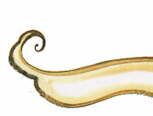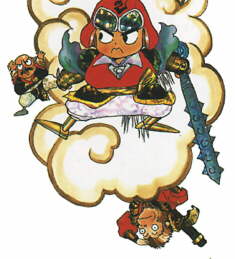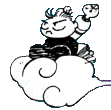- Shirow on Orion
Passages taken from Intron Depot 1 ©1991 Shirow/Seishinsha - Origins of Orion
Free translation from an Italian article by Luca Magnani. - More notes
Thanks to Susano-oh!


Orion is a light-hearted manga: sort of comedy based on Japanese mythology seasoned with H.P. Lovecraft's Cthuthu myths. It's the story of Earths genesis (destruction?) triggered by sorcerers in super-ancient times who summon gods and use special nine-headed Naga rituals (this is obviously fiction and I beg forgiveness of any Christian or Hindu readers -- all religions have their own creations myths, after all). I may have gone over board a bit with all the kanji double and triple meanings that I used but it is a rather conceptual story and I had a lot of fun drawing it. Perhaps as a result, Orion also has a slightly raw rhythm to it. Interestingly the target reader-ship turned out to be quite a bit different in the end than I had originally planned. I think of Orion as being in the same view as Black Magic, and sort of a counterpart to Appleseed.
[...] Ironically, before the details for the Orion project were finalized, I had planned to do the entire story in full color.
Franco: sometime Shirow uses words with multiple meanings, but it is a common practice inside Orion. Look at these examples described by Shirow himself: "Even native speakers may have different reactions to the multiple meanings I've built into the story through the Japanese characters. For example, in Japanese, the nine-headed beast called a naga which appears in Orion could be read "kutoryu" in kanji (Chinese characters), which could then be corrupted to Cthulu, which is obviously a reference to H.P. Lovecraft's octopus-shaped mythological creature. The cubular warheads are a double pun on the Japanese word "kaku", meaning both cubular and nuclear. It goes on and on."
Unfortunately we (Westerns readers) are unable to understand them. I hope that people who adapts Shirow's manga would know well their work.
In Appleseed Hypernotes there are some comments by Shirow about Orion (but there should be the same at the end of the Dark Horse edition) and a sort of dictionary. This one seems really interesting, but Japanese text only!
GN Japan has released a computer network game (NRPG) based on this manga.
There are a lot of points of contact between Orion and the Kojiki (1), one of the most ancient texts of the Japanese culture, drawn up by erudite Yasumaro during the feudal period. Shirow adapts in Orion what Yasumaro called the Myth of Izumo's dragon (2), whose main character is Susano, Amaterasu's (progenitress of the Japanese Imperial Family) younger brother. In the Kojiki, Susano is described as impetuous and courageous, always in conflict with the others Shintoist Gods.
In the manga, the couple yin-yang is connected to the binary system and Izumo is the name of the ritual used to evoke Susano. As in the the Myth of Izumo, the dragon must eat a female land principle (in the comic Kushinata stands pondering inside the monster, as if she was devoured) to exist. A male air principle (Susano) fights against the dragon, a destructive and chaotic force who has been evoked paradoxically to restore the natural order and to unite to his complementary (Kushinata). The dragon is an indefatigable eater, but he doesn't consume really. In fact inside the monster it's possible to find what he has eaten (either a princess or a magic weapon), so he doesn't produce too. He is like a suspension of the natural cycle of born, growth, decline, death (the main forces of which are creation and destruction).
[ Obviously the original Italian article is better than my version. ]
 On the other hand his complete name is Take haya Susanoo no mikoto which can be translated as "the valiant divine being who advances impetuously." Born from the creator Izanami's breath (3), he represents the Wind and he is considered terrible and benevolent at the same time because the force he controls can bring destruction (storms and submarine earthquake) and life (rain on the fields).
On the other hand his complete name is Take haya Susanoo no mikoto which can be translated as "the valiant divine being who advances impetuously." Born from the creator Izanami's breath (3), he represents the Wind and he is considered terrible and benevolent at the same time because the force he controls can bring destruction (storms and submarine earthquake) and life (rain on the fields).
In the Myth of Izumo, Susano arrives in the Izumo's district (after another disagreement with the other Gods) where he knows a couple of minor spirits who are worried about the life of their daughter. In fact Yamato no Orochi (a huge dragon with a lot of heads) infests the district and wants the life of a girl as tribute. The name of the beautiful young girl is Kushinata-hime who means "the marvelous sovereign (hime) of the rice fields" and Susano decides to help her. He prepares a large quantity of alcoholic drinks and when the dragon comes, enticed by Kushinata, he makes him drunk; then he challenges the monster.
During the fight, the Susano's "ten palms long sword" (4) hits one of the object swallowed by the dragon. It is Tsumukari (5) the "sharp sword", a magic spirit-sword who is able to pierce every defense. So the monster is defeated and Susano can marry Kushinata. They'll become the progenitors (6) of the king-priests who'll rule the region until it'll be absorbed by the Yamato Dynasty.
 |
 |
|
 The following notes conflict partially with the previous article, but since I'm ignorant about Eastern myths, I cannot judge who is right. Anyway I think that all this info are very interesting so I have reported them here. Thanks again to Luca Magnani and Susano-oh.
The following notes conflict partially with the previous article, but since I'm ignorant about Eastern myths, I cannot judge who is right. Anyway I think that all this info are very interesting so I have reported them here. Thanks again to Luca Magnani and Susano-oh.
1) The Kojiki is a book completed by O no Yasumaro and Hieda no Are in 712. Its purpose was to confirm the superiority of the Yamato Uji (clan) compared to the neighboring Uji, in particular the Izumo clan. Every Uji had a patron God, called Ujigami, which was supposed to be the progenitor. Since during the Emperor Tenmu age there were many conflicting legends, the Kojiki was written to rearrange them favoring the Yamato (whose leader became the Emperor of Japan) and declaring them Amaterasu's descendants.
There are many different religions inside the Orion manga. Often Shirow refers to Shinbutsushugo, which joins the Buddha and the Kami (Japanese) in a single thing. In fact Susano talks about Buddha as one of his bosses. Usually Susano is identified as the Buddhist God Gion.
Sirius belongs to a Chinese legend. |
||
 |
Pictures Copyrights
Title: Intron Depot ©1991 Shirow/Seishinsha. From the Top: 1-2) Intron Depot ©1991 Shirow/Seishinsha. 3) Intron Depot D ©1996 Shirow/Seishinsha/(?) respective companies. 4) Intron Depot ©1991 Shirow/Seishinsha. Left: Orion ©1991 Shirow/Seishinsha. |
 |
orion |
 |
||||||||||||||
This page hosted by